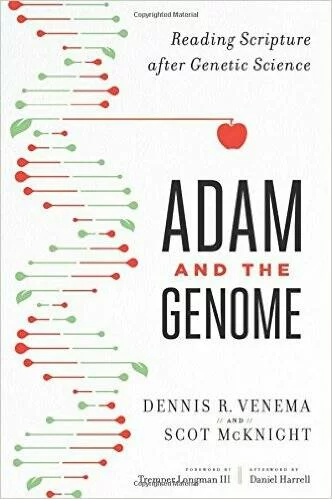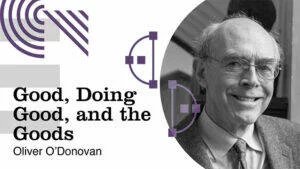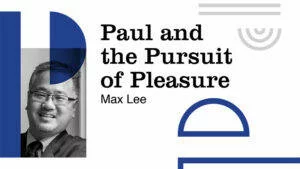In Adam and the Genome, my friend Scot McKnight presents his biblically rooted case for claiming that the term historical Adam is really about a literary or archetypal Adam.
It is the argument of Chapters 5-8. To drive the point home the term historical is placed in quotes (“historical”) as he introduces the topic (p. xi; also pp. 106-07). In this introduction, Scot posits that genetics proves that Adam and Eve cannot be historical individuals in a way that allows no quotes around the term. He returns to this sequence on p. 171. This makes the order of the book important. It starts with science and then goes to theology. I am not a scientist, so I cannot engage the claims of science directly. Others will do that in this series. I will work with the biblical texts.
It is in the context of theological hermeneutics that his biblical discussion of a distinction between a literary Adam and a historical Adam becomes important. The order of our discussion is also important. Historically, Christians have regarded the distinction between natural revelation and special revelation as significant. Natural revelation is how we read the material world around us for what it tells us about God. That reading is not regarded as inspired in any way. It is described and discerned. Special revelation is inspired by God. Now, as history shows, we do not read that revelation infallibly, so it is always important to ask what special revelation is saying to us. It is also fair to do so. So I want to consider the category distinction McKnight contends for as he discusses the theology tied to Adam. Is he an archetype only?Is he an archetype only? Might one contend he is an archetype who also is a historical figure? Might one contend he is an archetype who also is a historical figure? How might one make a distinction and should one do so?
It is here where I think Scot and I read the text distinctly. I believe the biblical texts and the history of how those texts were read shows that Adam is both an archetype and a historical figure, not just a literary figure only—for that would make him into something merely symbolic, a vaguely defined figure, an archetypal cypher only for humanity.
I will first look at the biblical texts. Then I will look at how those texts were read in the context and time frame of those who appealed to these accounts.
Hearing the Signals: A Look at the Biblical Texts
I agree with Scot’s four principles as stated in chapter 5 when we read the text. (1) We have to respect the speech of the context. (2) We have to be honest about the facts both in science and the text. (3) We have to be sensitive to the student of science. (4) We have to affirm the primacy of Scripture for what it says. Please note that point 4 is what we are discussing. Also note that when science speaks on issues of origins there is a great deal of theory and hypothesis about how it works, especially when claims are made by Scripture that God acted in the midst of sequences. When there is recognition of God’s ability to act by scientists, it does come with some awareness that tracing that ability is something science cannot confirm. That is because those actions are part of the special acts of God, not a part of God’s normal created order. We might see its consequences or be able to see its effects but we cannot materially review its presence as none of us can recreate its original environment. We can only hypothesize about that.

Baker Academic (2017)
Note one other thing in Scot’s list, the order. Like the book as a whole, the order is let’s talk about principles tied to science before we get to the texts. Now this is not necessarily a problem, as one of the checks in thinking through this process is to posit some level of unity between what God has done in setting up the material world to run on its own and what he has done at His own, more direct initiative. But the distinction between more natural and special acts remains. Special acts are also disclosed in the revelation God gives us. Resurrection is such an act; so is creation (however it is conceived theologically). That should include signals the text is making such a point, indicating such an event. Those signals are what I will be looking for in discussing the hunt for a possible distinction.
So we turn now to the textual discussion. As Scot argues for a distinction between archetypal/literary, genealogical and historical Adam, an important question is how can we see those distinctions, especially when there is the possibility these can overlap? One category needs to exclude the presence of the other category for his distinction to work. In particular, sorting out how we can have a genealogical Adam but not a historical one becomes important for this conversation.
Archetypes, Prototypes, & Adam
It is here our texts raise a question. As Scot worked through the Ancient Near Eastern texts, he rightly noted that some elements look parallel in form, expression and ideas, and some challenge those narratives. Genesis is a book of a series of roots, including the origins of Israel, an entity that has archetypal features of the people of God but also is about a nation, showing that literary and genealogical features do not automatically exclude the historical. The fact that we have genealogical listings in Genesis and 1 Chronicles suggests we are in the same kind of reality and genre whether we are discussing Israel or the period before. These listings go back to Adam. The archetypes in these chapters are firsts, not fictions. This is often how archetypes work. The cross has the archetype in the Passover. Redemption has an archetype in the Exodus and in the original Creation as it moves into new creation. Archetypes come with historical prototypes.
Now note what this observation about not being a fiction does not address. It does not address if there are some form of material precursors to Adam. One thing science does tell us is that life shares certain kinds of properties between species, from less complex to more complex. Scripture indicates categories of life as well that God was involved in actively generating. The Gen. 1 text merely presents Adam as the first of his kind, being made expressly in God’s image,The archetypes in these chapters are firsts, not fictions. This is often how archetypes work. being given and created with the ability to relate to God and manage the creation in ways other beings cannot. The focus on the role of image is also part of Gen. 2, breathing in Adam the breath of life.
I make this observation because McKnight’s listing of seven things entailed in a historical Adam on pp. 188-89 may not be what the category requires and that definition is another key to making his argument work. What existed suddenly in the creation has to do with the presence of the image of God in beings that makes a human, a moral being, a creation God is said to be responsible for introducing directly. The capability to choose wrongly and in a way that alienates from God also came with that creation, something Genesis 3 portrays. It holds Adam responsible in part because Adam and Eve were paired together so they might help each other in that responsibility. Both together make up the fullness of the image of God. When Adam failed, both sides of the human image pairing failed, the original creation of the image in diversity failed, impacting all sides of the human-image equation. Romans 5 seems to park on that moment and choice as what makes humans moral and culpable and in need of a Christ to reverse the damage done, whether it is because Adam sinned or because all sin like Adam did.
This failure portrays neither a mere symbol (“everyman”) nor merely a category of real kind (portraying sin without being a real event), but an event in kind, archetypal, for sure; but also a real, failed response. The type resides precisely at the point at what makes people human and in need of redemption, beings with accountability to God, beings who can choose otherwise at their own peril, just as the scene involving Adam shows. So when Adam does show up in Jewish literature and in the Hebrew Scripture, it is often (but not always) with this event in view. In several texts when lists of saints are noted, he is included in listings where other figures are not distinguished as being literary or genealogical versus historical but as all these categories at once (4 Ezra 7 [esp. v. 118]- “Oh Adam what have you done?”; Jub 4:10- “Adam knew Eve, his wife, and she bore 9 more children”!; Sir 49 as part of a much longer listing, including mention of kings, but closes with “above every other living being was Adam” after mention of Shem, Seth, and Enosh; Josephus, Ant 162, goes through a family line; 2 Baruch 54:15-“Adam sinned first and brought death on them all”; 56:5-6, “this is the transgression, Adam, the first man, committed; for when he sinned untimely death came into being”). Paul is not “historicizing” anything here. He is reporting on what took place, something Acts 17:26 also does in passing in Paul’s speech at the Areopagus, something Jesus also implies when discussing marriage in Matthew 19:4-6 and Mark 10:6-9. The archetype is a prototype.
What the Text Keeps Together
Much of the content analysis McKnight makes is correct in terms of the themes highlighted, but he seems to put asunder what the text keeps together when it comes to portraying the core events of human creation and fall. The prototype is found in the nature of the creation and choice. God initiated the creation of Adam in the likeness of God’s image, unlike anything before him. Adam completed the rebellion of that image when he acted in conjunction with Eve. Paul does not historicize Adam, he enshrines the history of Adam’s act in a context where Scripture comes first and returns to this event as a marker.We are like Adam because we are like a real Adam, even connected to him through his sin. Romans 5:19 says many were made sinners through him. We rebel as he rebelled as his act impacted us. Everything about that statement would seem to require a real being, not just an “everyman.” Christ undoes what Adam did because Adam did something concrete, not merely symbolic and not merely in kind. All our texts pointing to this scene argue this way. I am contending that the key thesis 5 on pp. 188-89 is a non sequitur. Paul does not historicize Adam, he enshrines the history of Adam’s act in a context where Scripture comes first and returns to this event as a marker. Scot’s hesitation to accept Dunn’s description of his position as myth reflects the no man’s land his argument puts him in. The question begs, “Why not call it myth if there is no historical event in view?” Literary Adam without a historical Adam makes Scot’s distinction from a mythic Adam a distinction without any real difference. And so, as much as I appreciate much of what Scot says about Adam, in this last key step the argument comes up significantly short, both in terms of genre analysis and as a theological statement.







Comments
Be the first one to make a comment!